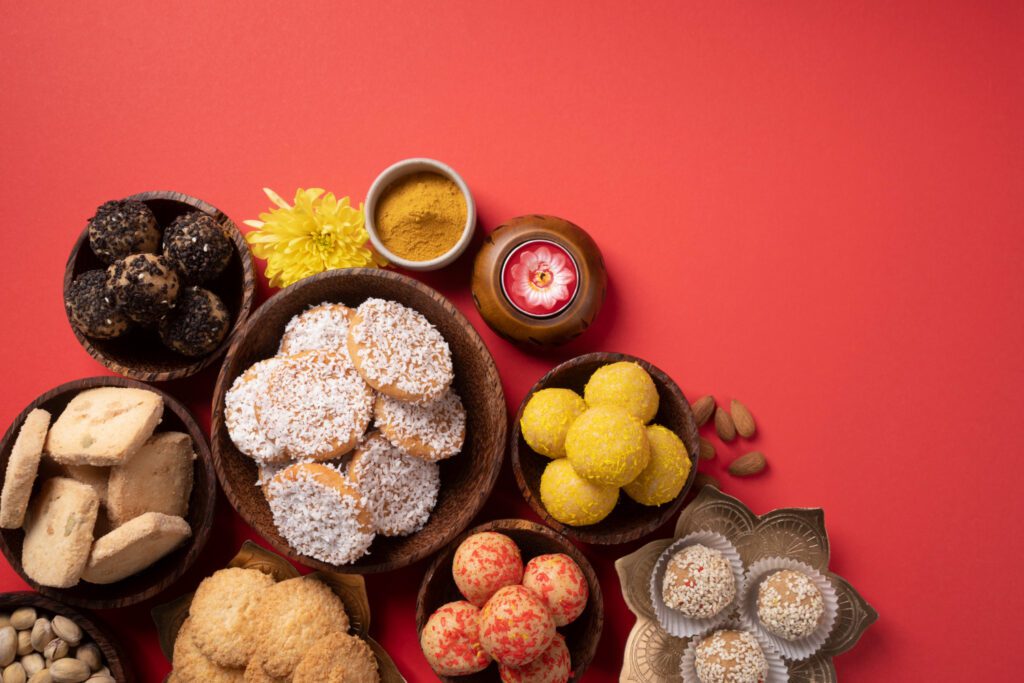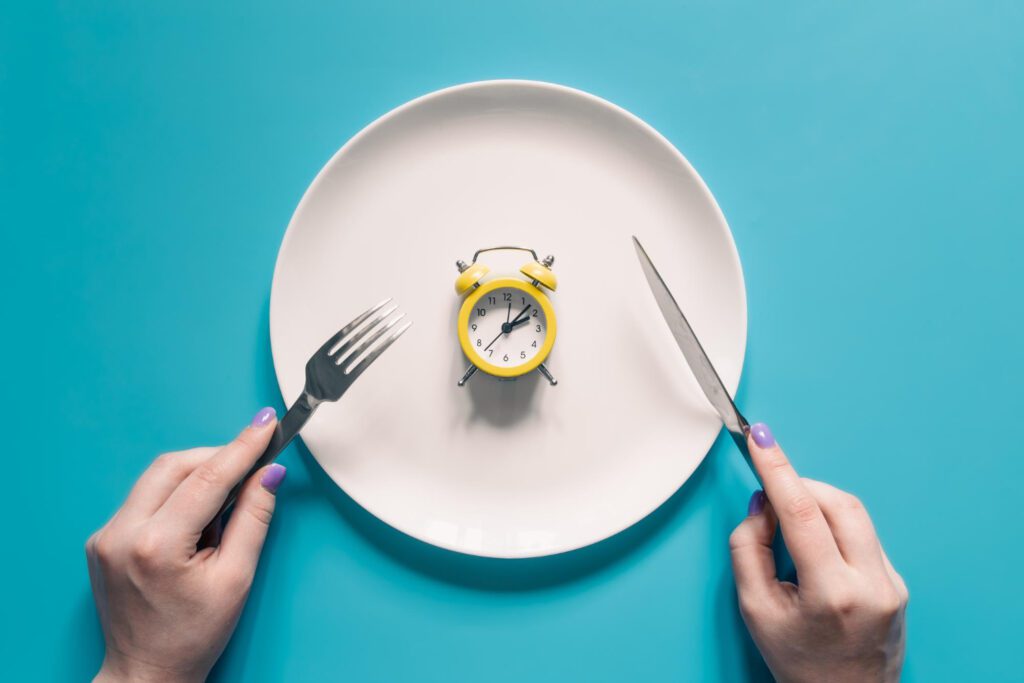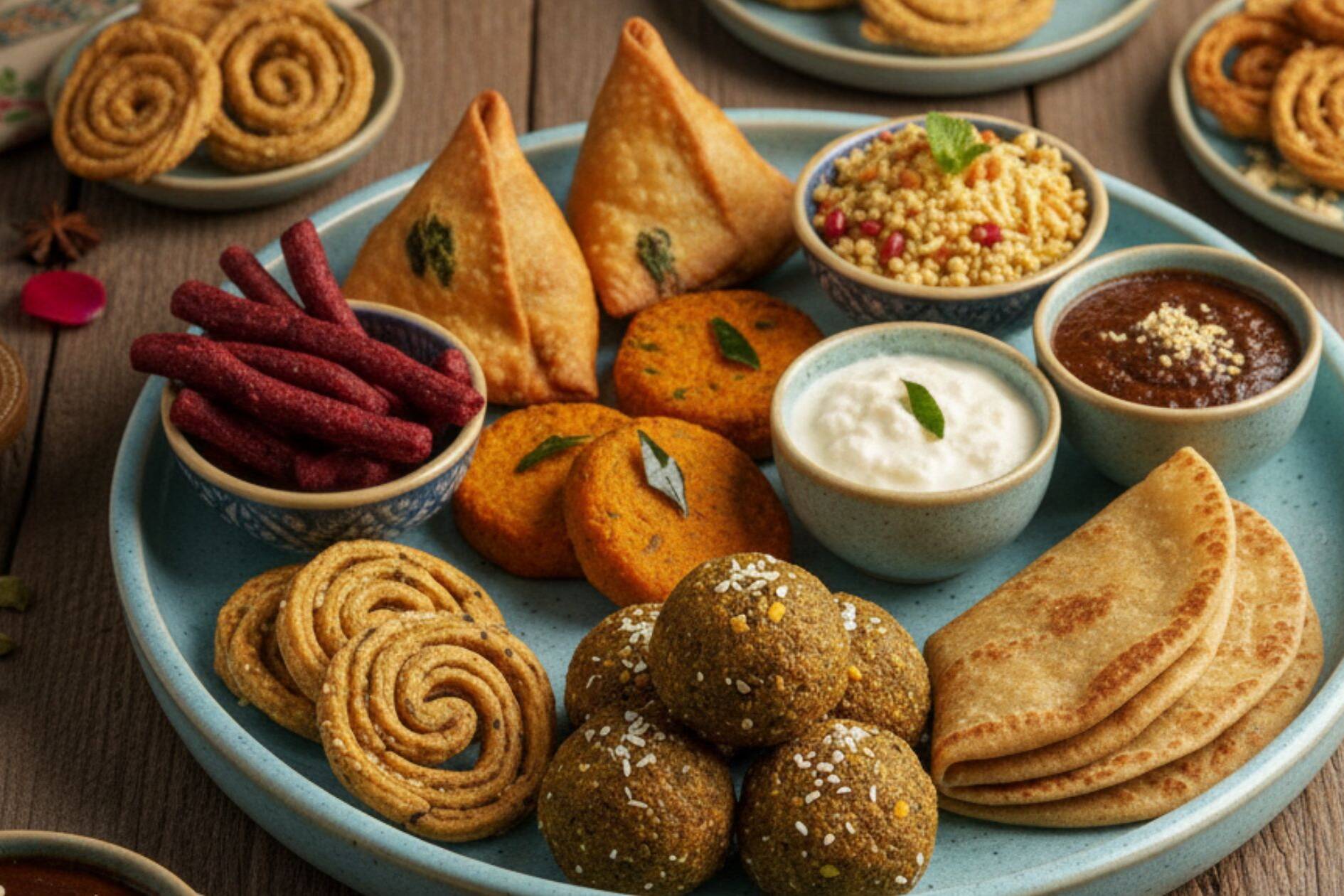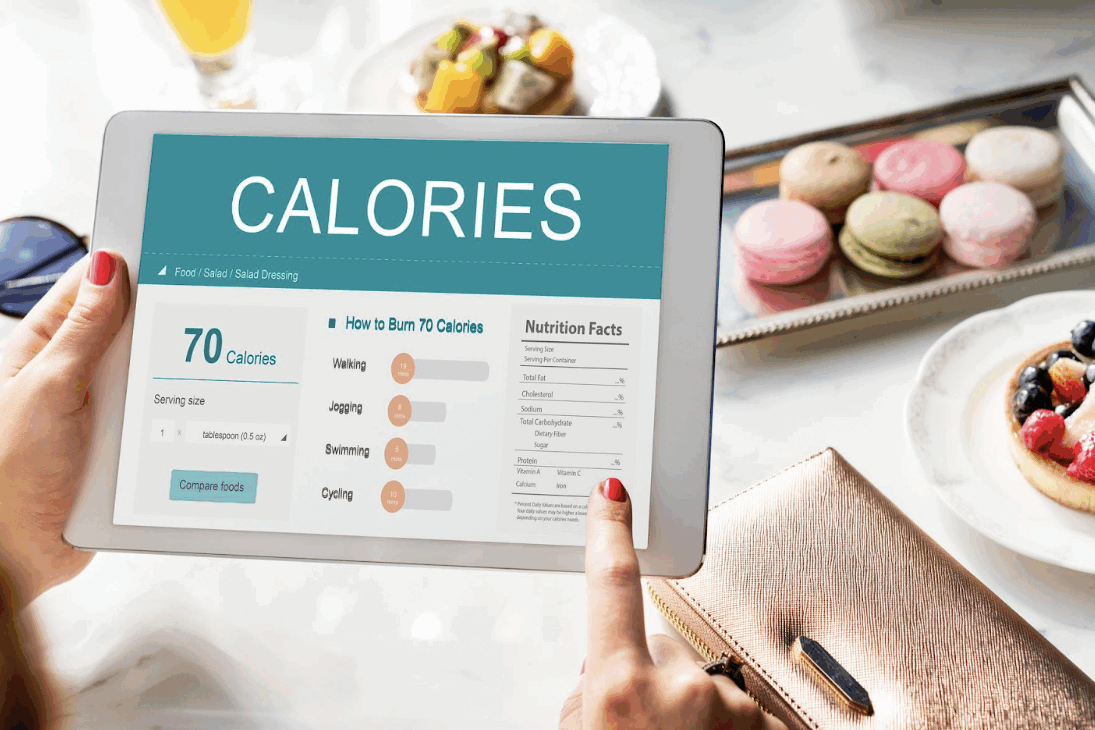Every year, as the season changes and Navratri approaches, I see so many people excited to fast, but also confused about what to eat, how much to eat, and how to balance their energy through these nine days.
Let’s go back to where it all began. The word Navratri comes from two Sanskrit words — ‘Nav’ meaning nine and ‘Ratri’ meaning nights. These nine nights are dedicated to the worship of the divine feminine energy, Maa Durga, in her nine forms.

Traditionally, it marks the transition between seasons — from monsoon to autumn — and was designed as a time for deep cleansing, both physically and spiritually.
Fasting during Navratri was never just about avoiding certain foods. It was (and still is) about aligning our bodies with nature’s rhythm, giving the digestive system a break, and preparing the body and mind for the next season. Ancient texts mention how light, easy-to-digest foods during these nine days help maintain digestive fire (agni), balance hormones, and support mental clarity.
But here’s what I often notice:
Some people end up eating fried foods and sugary sweets all day in the name of fasting and feel heavy, bloated, and sluggish. Others barely eat anything, thinking ‘less is better,’ and by the third day, they’re exhausted, irritable, and craving everything in sight.
This is where we often miss the true essence of fasting.
In this guide, we’ll explore everything you need:
- How to do Navratri fasting correctly – without feeling weak or irritable
- A complete Navratri fasting food list that will keep you full and satisfied
- Safety tips and common mistakes to avoid during these nine days
- Practical plate-building and meal-prep ideas to make fasting simple and sustainable
Whether this is your first time observing food in Navratri fasting or you’ve been doing it for years, this guide will help you make it a more mindful and nourishing experience.
How to Do Navratri Fasting?
Over the last decade, we’ve had the privilege of guiding thousands of people across India and the world through fasting — whether intermittent fasting, therapeutic fasting, or religious fasting, such as Navratri. And here’s what we’ve learned: Fasting done right is one of the most powerful gifts you can give your body and mind.
But let’s get something clear. Navratri fasting is not about depriving yourself or punishing your body. It’s about making space — physically, mentally, and emotionally. It’s a way to give your digestion a break, eat lighter, and turn inward.
Unfortunately, many of us have turned fasting into either a food feast or a food famine.
- Feast mode: Overloading on fried sabudana vadas, pakoras, sugary halwas, and deep-fried chips throughout the day.
- Famine mode: Eating almost nothing till evening, drinking multiple cups of chai, then binging when hunger hits — which leads to acidity, bloating, and sluggishness.
Neither is healthy. Neither is the true purpose of Navratri.
So let’s break it down — scientifically and practically — and see how you can make this Navratri a period of strength, cleansing, and mental clarity.
Core Principles of Navratri Fasting
Here’s what to include and what to reduce:
Hydration Comes First
- Start your day with warm water or lemon water with a pinch of pink salt.
- Drink water throughout the day, not just when you’re thirsty.
- Coconut water and buttermilk are excellent for hydration and electrolytes.
Eat Light, Natural Foods
- Choose foods that are fresh, seasonal, plant-based, and easy to digest.
- Include fruits, fresh vegetables, curd, A2 milk, paneer, nuts, seeds, and fasting grains like kuttu (buckwheat), samak rice, singhara flour, and sabudana.
- Avoid heavy foods like wheat, rice, lentils, onion, garlic, processed snacks, and regular table salt.
Spices: Keep it Gentle
- Use spices like cumin, black pepper, and green chilli to boost digestion.
- Limiting hing, mustard seeds, and turmeric if you follow traditional customs during Navratri.
- This makes meals flavorful yet gentle on your stomach.
Don’t Skip Meals Entirely
- Navratri fasting doesn’t mean starving all day.
- Skipping meals can drop blood sugar, leading to weakness, irritability, and cravings.
- Instead, space out smaller meals and snacks throughout the day to keep energy stable.
Why Meal Composition Matters — The Science
When you fast, your body shifts gears — it becomes more efficient at using stored energy. But what you eat during your eating window will determine whether you feel energetic or completely drained.
| Meal | What to Aim For | Why This Helps |
| First Eating Moment/Early Break-Fast | A combination of easily digestible carbohydrates + some fats + small amount of protein. E.g., a sabudana preparation with peanuts, or something made with kuttu or singhara flour along with curd or a little nuts. | Carbs give immediate energy, fats slow absorption so you don’t get a sugar spike, protein helps avoid feeling weak soon after. |
| Midday/Main Eating Window | More complete macro distribution: moderate carbs, good protein (milk, curd, paneer, nuts), healthy fats (nuts/seeds, maybe ghee in small amount), and a decent portion of vegetables. | This supports sustained energy so your afternoon doesn’t collapse. It helps keep blood sugar stable and supports digestion (since your gut has had some rest earlier). |
| Snack/Between Meals (if needed) | Light, easy stuff: roasted nuts, a bit of fruit, maybe curd, or something like roasted makhana. Avoid heavy sweets or fried snacks. | Gives an energy boost without overwhelming the system; helps you stay balanced until next meal. |
Science & Experience Behind This Pattern
- When we eat carbs without enough protein or fat, there is often a quick rise in blood sugar, followed by a crash, leading to dizziness, fatigue, and mood swings. Including protein + fat slows absorption.
- Mixed-macro meals (carbs + protein + fats) help maintain better glucose control, even in fasting or restricted eating settings.
- From my clients’ feedback, people who begin their fasting days with only sweets or heavy fried items often feel heavy, bloated, and have low energy by midday. But those who start moderately with balanced macro meals stay more alert, less hungry, and less tempted to overeat later.
If you follow this structure — good carb + protein + fats in the first eating, a balanced mid-day portion, and light snacks if needed — your body will feel supported. You’ll have energy, a clear mind, less discomfort, and a deeper sense of well-being during Navratri.
Note:
Fasting is a therapeutic tool — but it is not one-size-fits-all. If you have diabetes, hypertension, are pregnant, lactating, or on medication, please speak to your doctor before making any major dietary changes. What I share here is general guidance from my experience and research, not medical advice.
Navratri Fasting Food List: What to Eat
Below is a detailed table of foods—what they bring, and how they support you.
| Category | Foods | What They Provide / Why They Are Good |
Allowed Flours & Staples | Kuttu (Buckwheat) Flour — rotis, pancakes, cheelas | High in quality protein, fibre, flavonoids; helps reduce insulin resistance, supports lipid profile. |
| Samak Rice — khichdi, pulao style dishes | Provides complex carbohydrates with slower digestion, preventing sugar spikes. | |
| Singhara (Water Chestnut) Flour — puris, halwa | Rich in micronutrients and antioxidants; good for lighter dessert variations. | |
| Sabudana (Sago) | High in starch, gives quick energy; when paired with peanuts or curd, gives balanced energy + protein. | |
Fruits & Vegetables | Bananas, apples, papaya, pomegranate | Natural sugars + fibre + antioxidants to protect cells and support digestion. |
| Pumpkin, bottle gourd, sweet potato, raw banana, potatoes, cucumber | Vegetables with water content, fibre, vitamins; sweet potato is low GI compared to white potato. | |
Proteins & Healthy Fats | Paneer, curd, A2 milk | Dairy protein is complete; curd also provides probiotics. |
| Almonds, cashews, peanuts, pumpkin seeds, makhana | Nuts/seeds deliver healthy fats, minerals; makhana is light but satisfying. | |
| Ghee or cold-pressed oils (in moderation) | Healthy fats help absorb fat-soluble vitamins, support joint lubrication and satiety. |
My Practical Advice:
- Pair smartly: When you eat sabudana or sweet potato (carbs), combine with peanuts or curd (protein/fat) so the energy release is smoother.
- Cook simply: Light boiling, steaming, roasting, or dry-toasting work better than deep frying. The lighter the cooking method, the easier your digestion.
- Watch quantity & timing: Bigger portions early in the day will serve you better than heavy dinners. Evening meals benefit from lighter vegetables + protein.
Food List in Navratri Fasting: What to Avoid
Here’s a clear, detailed table of what to avoid — and why.
| Category | Foods to Avoid | Why to Avoid Them |
| Grains & Cereals | Wheat, rice, oats, barley | Too heavy for digestion during fasting, spikes blood sugar quickly. |
| Legumes & Lentils | Chana, rajma, toor dal, moong, beans | Harder to digest without spices like hing/garlic; can cause bloating and discomfort. |
| Onion & Garlic | All forms | Traditionally avoided for their tamasic (heat-producing) nature; can irritate gut for sensitive individuals. |
| Animal Products | Eggs, meat, fish | Hard to digest and not part of traditional Navratri practice. |
| Processed & Packaged Foods | Chips, namkeen, biscuits, packaged sweets | Contain refined oils, sugar, and additives that cause inflammation and lethargy. |
| Refined Sugar & Deep-Fried Junk | White sugar, overly fried sabudana vadas, pooris | Spike insulin, lead to energy crashes, promote fat storage. |
| Regular Table Salt | Iodised or refined salt | Can cause water retention and bloating. |
My Practical Advice:
- Read labels — Even ‘fasting snacks’ can be loaded with hidden sugars and refined oils.
- Homemade > Packaged — Make a simple roasted makhana or dry fruits mix at home.
- Balance, Don’t Over-Restrict — It’s not about eating less, but eating right.
Meal Recipes — Luke’s Favorites for Navratri
Here are a few of the recipes curated by Team Luke. These are tried, tested, nourishing, and designed to give you energy without heaviness.
Phool Makhana Paratha
Why I love it: Makhana (fox nuts) is light, crunchy, and full of satisfying texture. I also call it the Great Indian Popcorn. When made into a paratha with minimal oil, it gives you carbs, fibre, and a little protein — perfect when you need something filling but gentle.
Ingredients (for ~2 parathas):
- Phool makhana (fox nuts), crushed/ground into coarse powder
- Kuttu flour (or singhara flour)
- A little curd or milk (to bind)
- Grated/gently cooked vegetables of choice (if permitted)
- Mild spices: cumin, black pepper
- Ghee (very little, for cooking)
Method:
- Crush makhana into coarse powder — you want some texture.
- Mix in kuttu flour, curd/milk, spices, and enough water to make a soft dough.
- Rest the dough for a few minutes (5-10).
- Divide, roll gently (you can use flour from singhara or kuttu to avoid sticking).
- Cook on a hot tawa (griddle), using a little ghee/good oil, on both sides till golden brown.
Sabudana Khichdi with Peanuts & Cucumber
Why I share this often: It’s a fast classic — gives you carbohydrates (from sabudana), healthy fats/protein from peanuts, hydration from cucumber. Helps avoid mid-fast fatigue when paired well.
Ingredients:
- Sabudana (soaked sufficiently)
- Roasted peanuts (slightly crushed)
- Cucumber (fresh, diced)
- Potato or sweet potato (optional, cubed and lightly boiled)
- Mild spices: black pepper, cumin, green chillies (if your system allows)
- Ghee or light oil (very little)
Method:
- Soak sabudana ahead (as per instructions) so that they are soft.
- Boil potatoes/sweet potatoes separately if using.
- In a pan, heat a little ghee/oil, roast peanuts lightly, then add potatoes, and sabudana.
- Cook till sabudana becomes translucent and slightly soft.
- Toss in a cucumber at the end for freshness.
Light Kheer/Sheera with Singhara
Why I include this: Dessert often feels forbidden during fasts — but you can have something sweet without overloading. Using singhara flour/arrowroot with minimal sweeteners and lots of taste gives joy + nourishment.
Ingredients:
- Singhara flour (or suitable fasting flour)
Milk (or plant-based if your fast allows)
Natural sweetener (such as jaggery or coconut sugar in permitted amounts)
Cardamom or mild spice for flavour
Method:
Roast the singhara flour slightly for a nutty aroma.
Add milk gradually, stirring continuously to avoid lumps.
When the mixture thickens, add sweetener.
Season lightly with cardamom.
For more delicious and nutritious meal ideas, refer to our Ultimate Navratri Recipe Booklet.
Hydration, Electrolytes & Energy Balance
One thing I’ve observed is that many people underestimate how critical hydration is. Our body works quietly in the background — digestion, circulation, brain function — all needing water. If you skip this, you sabotage your fast.
Here are a few practices to make your Navratri fasting feel empowering — not exhausting.
| Principle | What to Do | Why This Helps/Scientific Basis |
| Drink regularly through the day | Sip plain water frequently — don’t wait till you feel very thirsty. Set reminders if needed. | Your body loses water continuously (through breath, sweat, even respiration). Small frequent sips keep your hydration stable. When dehydrated even by 1–2%, energy, mood and digestion suffer. |
| Use natural hydrating fluids | Include coconut water, buttermilk (diluted with water), fresh fruit juices light-on-sugar (if permissible), and water-rich fruits like cucumber or watermelon. | These fluids give not just water but also electrolytes and minerals that help cell function and reduce fatigue. |
| Balance energy sources: Carbs + Proteins + Fats | When you have carbs like sabudana or potatoes, pair them with protein sources (peanuts, curd, paneer). Also include healthy fats (nuts, seeds, a little ghee or good oil). | Carbs alone give a quick surge then drop; mixing macros lends steadier blood sugar, fewer crashes, more stable energy. |
| Hydration monitoring & awareness | Track how much water you are drinking. Observe signs of dehydration: dark urine, dry mouth, heaviness, dizziness. Adjust accordingly. | Simply meeting your body’s daily hydration needs can ease fatigue, improve digestion, and even reduce those nagging fasting headaches. |
My Practical Advice:
- Start your day with a glass of plain water (room temp) before you eat anything.
- Keep a water bottle with you — whether at home, work, or during puja — and try to sip at regular intervals (for example every 30-45 mins if possible).
- Use coconut water or buttermilk in the mid-morning or mid-afternoon if you feel heaviness or sluggishness; these act like gentle internal coolants and help digestion.
- In hot climates (Mumbai, Delhi, etc.), or when doing physical tasks or puja chores, increase your fluid intake consciously. Sweat drains water and minerals, so hydration needs go up.
Common Mistakes & Safety Precautions
Navratri is a beautiful time to cleanse your mind and body — but over the years, I’ve seen many people unintentionally harm themselves in the name of fasting. Here’s what I always remind my community:
Overeating Fried Foods and Sweets
Just because it’s ‘fasting food’ doesn’t mean it’s free from consequences. I’ve had clients who ended Navratri with weight gain, bloating, and acidity — not because they fasted, but because they turned every meal into a mini-feast of deep-fried sabudana vadas and sugary halwas.
- My advice: Keep fried foods occasional. Use ghee or cold-pressed oils mindfully and try roasting, baking, or pan-cooking instead. Respect portion sizes. The goal of fasting is lightness — not overburdening your gut.
Avoid Tea & Coffee – Stick to Water
Many people reach for chai or coffee multiple times a day to suppress hunger, but during fasting this can backfire — leading to acidity, irritability, and even poor sleep.
- My advice: Skip tea and coffee completely on your fasting days. Instead, prioritize plain water to stay hydrated and prevent headaches or fatigue. Your body will thank you for the clean break.
Neglecting Vegetables and Variety
Fasting does not mean eating only potatoes and sabudana. When you ignore variety, you set yourself up for constipation, low energy, and nutrient deficiencies.
- My advice: Add fibre and colour. Use cucumber, bottle gourd, pumpkin, and other fasting-friendly veggies. Pair carbs with peanuts, curd, and paneer for better satiety and blood sugar control.
Not Personalizing Your Fast
This one is crucial. If you have diabetes, hypertension, thyroid issues, or are on medication, you cannot just copy someone else’s fasting pattern from Instagram or your neighbor’s plate.
- My advice: Always consult your doctor or nutritionist before starting. You might need to adjust meal timings, portions, or even your medicines. Fasting should support your health — not put you at risk.
Listen to Your Body
If you feel dizzy, weak, or nauseous, break your fast gently. Fasting is meant to heal, not harm. There is no ‘one perfect way’ — choose what works for your body, not what is trending.
Navratri Fasting Tips for Diabetics
If you’re living with diabetes, fasting during Navratri needs extra mindfulness — not fear. Over the years, we’ve worked with hundreds of diabetics who wanted to keep the spirit of Navratri alive without compromising their health. Here’s what I recommend:
Before You Start
- Consult Your Doctor: Always check with your physician before fasting, especially if you’re on insulin or medication.
- Do a Pre-Fast Check: Get your blood sugar, blood pressure, and kidney function reviewed so you know where you stand.
- Plan Ahead: Decide meal timings, foods, and hydration strategy in advance to avoid last-minute confusion.

During Fasting
- Don’t Skip Meals Entirely: Spread out 3–4 small meals instead of one big feast — this keeps blood sugar stable.
- Choose Low-GI Carbs: Opt for samak rice, sweet potatoes, pumpkin, and kuttu instead of fried, starchy preparations.
- Pair Carbs with Protein: Add curd, paneer, or nuts with every meal to slow glucose spikes.
- Watch Portions: Overeating even ‘fasting-friendly’ food can lead to hyperglycemia.
- Hydrate Consistently: Space out water, buttermilk, and coconut water to prevent dehydration and dizziness.
- Avoid Long Gaps: Don’t wait until you are starving to eat — it can lead to hypoglycemia.
Monitor Closely
- Check Blood Sugar More Frequently: Especially if you feel weak, dizzy, or overly hungry.
- Know When to Break the Fast: If your sugar drops too low or you feel faint, eat a balanced snack immediately. Your safety comes first.
When Fasting May Not Be Safe
- If you have uncontrolled diabetes (frequent hypo- or hyperglycemia)
- If you are pregnant or have kidney complications
- If you have had recent severe hypoglycemic episodes
- If you’re unwell or recovering from an infection/illness
My Note:
Navratri fasting can be safe for most diabetics if done mindfully. It’s not about skipping food — it’s about choosing the right food at the right time. Respect your body’s signals, and don’t compare your fast with others. Your health is your biggest prayer.
The Last Word
As we come to the end of this guide, I want to remind you that Navratri fasting is not just a ritual – it’s a celebration of your body, mind, and spirit.
The way you choose your food in Navratri fasting can either uplift you or drain you. When you know how to do Navratri fasting the right way — with balance, hydration, and mindful food combinations — you nourish your cells, stabilize your energy, and feel light yet strong throughout the nine days.
Most importantly — listen to your body. This Navratri, let your food become your offering, and let every meal remind you of the divine energy within you.
Frequently Asked Questions
What foods are allowed in Navratri fasting?
During Navratri, you can enjoy kuttu (buckwheat), samak rice, singhara flour, sabudana, potatoes, sweet potatoes, paneer, curd, fruits, and nuts. This Navratri fasting food list ensures your meals stay light yet nourishing, helping you maintain energy and focus throughout the day.
How to do Navratri fasting the healthy way?
The key to how to do Navratri fasting is balance — space meals evenly, stay hydrated, and include carbs, protein, and healthy fats in each meal. Avoid deep-fried snacks and excessive sweets. Choose wholesome food combinations to keep blood sugar stable and digestion smooth.
Can I drink tea or coffee while fasting?
It’s best to avoid tea and coffee during Navratri fasting. They can cause acidity, dehydrate the body, and disturb sleep. Stick to plain water as your primary source of hydration. If needed, you can sip on coconut water or buttermilk once or twice a day for natural electrolytes.
What mistakes should I avoid during Navratri fasting?
Common mistakes include overeating fried foods, skipping hydration, relying only on potatoes or sabudana, and ignoring vegetables. Following a diverse Navratri fasting food list with fruits, nuts, curd, and vegetables keeps meals nutrient-rich and prevents fatigue or bloating during fasting.
Is Navratri fasting safe for diabetics?
Yes — if planned well. People with diabetes should eat small, frequent meals, monitor blood sugar, and pair carbs with protein. This mindful approach to food in Navratri fasting prevents sugar spikes or crashes and makes fasting safer. Always consult your doctor before fasting.
Disclaimer: If you have certain food allergies, avoid foods that may trigger a reaction. The information provided here is for educational and informational purposes only. It is not intended as a substitute for professional medical advice, diagnosis, or treatment. Always consult your healthcare provider before making changes to your nutrition, lifestyle, or healthcare regimen, especially if you have existing medical conditions or are taking prescribed medications.
Want personalized guidance on how to do Navratri fasting?
We help you find a way.
Set up a one-on-one consultation with our integrative team or explore our Wellness Programs to optimize your lifestyle goals.
Reach out to us at 1800 102 0253 or write to us at consults@lukecoutinho.com.

Team Luke
Start Your Wellness Journey
Feeling inspired to take the next step in your wellness journey? Connect with us to explore how our tailored programs can support your health journey. Your transformation is just a conversation away.



